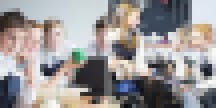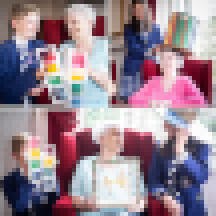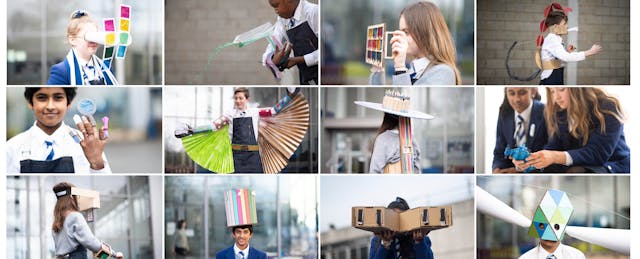As Cameron and Lewis sat mulling over the final details of the wheelchair fishing prototype they had designed for Bill, they enthused about how awesome it would be if Bill could regain his enjoyment of fishing, which he explained he had lost following a stroke. Cameron reflected on how it might encourage Bill to be more sociable and make more friends in his old age.
One table over, Alex, Iain, William and Roman were working on a social finger-knitting device they designed for Mary. Their idea? To empower Mary and her friends to knit simultaneously on the same garment. Alex hoped it would give Mary the sense of satisfaction she had described during her interview on the first day they’d met.

It had only been two weeks since these middle schoolers visited a local care home, Balmanno House, but they’d already made great strides in their challenge to design and fabricate a device that would not just restore, but augment the former abilities of the elderly care home residents.
These student-driven concepts were part of a design studio—“Super Enabling Devices”—which ran in October 2018 at Kelvinside Academy (KA), a 140-year-old independent school in Scotland. The studio was the first in a unique pilot to prepare the ground for the launching of Scotland’s first innovation school on site at KA. But what prompted Kelvinside to consider opening a center built around creativity and entrepreneurship?
Enter NuVu. Sandwiched between the Massachusetts Institute of Technology and Harvard University, this full-time innovation school for middle and high school students based in Cambridge, Mass., places creativity, critical thinking and collaboration at the heart of its pedagogy.
The learning model is based on an architecture design studio, and is a far cry from the assessment and standards-based paradigm of most education systems around the world. At NuVu, groups of 10 students work closely with coaches to solve real-world challenges. Additionally, NuVu’s learning model has a profoundly empathic dimension: by addressing real-world challenges, students acquire a personal understanding of the world and how they can impact it.
NuVu first came on KA’s radar in 2017 when Ian Munro, the Scottish school’s rector, was studying at Harvard. Around the same time, I arrived at Kelvinside to take on the role of head of languages after six years as chief learning architect at Kuato Studios, an educational games company based in London. What struck us was that NuVu follows no formal curriculum. Instead, students are challenged to solve complex problems that impact real audiences.
Despite an age difference of 130 years, it was love at first sight, and a unique partnership blossomed between the venerable independent school in Scotland, and the forward-thinking innovation school in the United States.
The first proof points for the partnership took the shape of two summer schools, one in 2017 and the other in 2018. On the Kelvinside campus in Glasgow’s leafy West End, students from middle and high school explored swarm robotics, created biofashion and programmed augmented reality games. They were mentored by a team of NuVu coaches to explore their creative instincts, while expanding their capacity to think and learn analytically. The intensity of engagement through this collaborative and experimental studio process was striking.
By the end of the summer camp experiment, we were intent on embedding NuVu’s approach into our existing curriculum at Kelvinside, and NuVu Fellow, James Addison was invited to join Kelvinside staff in August 2018 to run our Innovation Lab. Plans also hatched very quickly to launch the Kelvinside Academy Innovation School for students ages 5 to 18, based on the NuVu model.
What Does a Studio Look Like in Practice?
At the heart of the studio process is iteration. It is crucial that students are able to approach and solve problems freely, without feeling bound by rules. In a sense, the NuVu model captures the essence of a child’s ability freely to view and understand the world. There is no “right” answer. It’s up to the student how to proceed to build a solution, developing from concept to prototype via a range of iterations, sketches and reflections.
Prior to visiting Balmanno House, for the Super Enabling Devices studio, students considered how to frame their questions to the residents—starting broad, putting the interviewee at ease before moving on to general questions about residents’ former lives, and then delving into more specific questions relating to the challenge. Then followed a period of brainstorming, in which students formed groups by coalescing around shared ideas, which were gradually filtered until a starting point was agreed upon by each group.
Over the next two weeks—using laser cutters, 3D printers, wood, glue, cardboard, screws and almost anything else they could find—groups progressed through the prototyping phase. Early prototypes were often quickly realized, and quite rough, ranging from pencil sketches to cardboard designs, but they weren’t meant to look polished; the prototypes tested the validity of the solution. Also during this phase, students were subject to frequent “desk crits,” in which they were prompted by NuVu coach to validate their choices or expand on design decisions. Desk crits are common practice in architecture studios, in which the critique culture guides students rigorously through the design process while discouraging them from becoming too focused on a single perspective or solution.
At the end of each studio, prototypes are presented to the larger group. The presentation stage is also a core element of the studio experience. For this studio, each group was given five minutes to present their prototype, taking their audience, which included Balmanno residents, through the various stages of the process, reflecting on lessons learned, justifying their solution and saving time for a Q&A session toward the end.
Needless to say, the residents of Balmanno were delighted to be presented with the devices and contraptions, and had such fun testing them in the care home social areas.

Following the NuVu model, studios are topically diverse. After Super Enabling Devices, the studio undertaken by the next cohort, “Navigating the City,” asked students to consider the future of cities and challenged them to create body extension tools that would allow them to interact with the city in ways they never thought possible. One group produced a prototype for mood enhancing spectacles, designed to provide different perspectives of a city through color.
A third studio, “Cyborg Enhancements,” tasked students with exploring the ethical, social and technical implications of a biologically transformed cyborg society. Another studio in our pilot, titled “Fables Retold: Beyond the Book,” challenged students to analyze the structure of favorite fables and reimagine them through augmented reality, using narratives from their own lives as inspiration. In these adventures, students looked to their own communities, current events and life experiences to retell stories in a new, accessible medium for younger students in the lower school.
One of the most desirable qualities of the studio model is that there are no limits imposed on creativity or ambition. “But how are students being assessed?” is the most common question we get asked. It should come as no surprise that there’s a forward-looking approach to assessment, too. Within the NuVu model, students aren’t graded, but rather develop something of arguably greater value: a rich and considerable portfolio illustrating a student's growth over time and the development of key academic and life skills: creativity, critical thinking, collaboration, communication, research, quantitative reasoning and analysis.
This portfolio is key. While the results of standardized tests are still the principal currency for university admission, we intend to work with admissions counselors across the U.K. to consider the KA Innovation School portfolio as an equivalent tariff to a standard course. In the U.S., over 400 colleges and universities have expressed positive interest in receiving applications from students who have attended the NuVu program, and NuVu alumni have successfully been admitted to a broad range of universities.
School models that value creativity and critical thinking such as NuVu and the KA Innovation School, serve as examples of learning experiences that require alternative definitions of success and approaches to measuring growth. The move to build such models is connected to a broader goal: to rethink the route to university.
Much like how there are multiple pathways to solving a problem in our studio learning model, we think students should have multiple routes to university and toward career opportunities. After all, there is no “right” answer. Each student must decide on a path forward and schools can help guide them toward choices that will allow them to thrive in a rapidly changing world.


